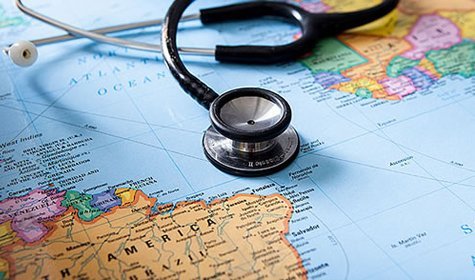Public health threats know no boundaries, and global security depends upon preparedness and collaboration in establishing sustainable public health systems around the world, said a panel of high-ranking experts at the George H.W. Bush Sixth China-U.S. Relations Conference hosted in Houston by Texas A&M Health Science Center.
“The bottom line is we’re in this together,” said The Honorable Nils Daulaire, M.D., M.P.H., former U.S. assistant secretary of health for global affairs and now senior visiting scholar on global health security at the Norwegian Institute of Public Health, regarding international efforts to enhance readiness, including providing resources and technical expertise to assist less developed countries. “This pays enormous dividends not only in public health but also in international relations.”
Session moderator Andrew Natsios, Texas A&M University director of the Scowcroft Institute of International Affairs and executive professor at the Bush School of Government and Public Service, said, “We have learned from Ebola that the emergency response system is not designed for massive pandemics. The question is how we deal with a fast onset pandemic that occurs outside our borders.”
How capable is the international community, he asked panel members, to respond to a pandemic such as the 1918 influenza outbreak, in which 3 percent to 5 percent of the world’s population died in 12 months?
Vice Minister Liu Qian of the National Health and Family Planning Commission of the People’s Republic of China responded, “One important lesson we have learned is that advances in technology are vital for rapid diagnosis. We also learned an isolation mechanism must be put in place in a very timely manner.”
“In terms of response it’s clear we don’t know where, what or when the next outbreak will occur,” Daulaire said. “When you don’t know you have to do things with an all-hazards approach. You have to be prepared to identify and quickly respond.”
Peter Hotez, head of the section of Pediatric Tropical Medicine at Baylor College of Medicine in Houston, spoke to the burden of disease on the world’s poor, who suffer disproportionately.
“Ebola virus infection is not new; it represents one of 20 diseases under the moniker of neglected tropical diseases,” he said. “The point is we want to be ahead of the curve and not reacting such as with the Ebola virus.”
Vaccine development is the piece that’s missing, Hotez said. “Private industry and the public sector need to find ways to cooperate,” Daulaire concurred.
They agreed that the three national Centers for Innovation in Advanced Manufacturing (CIADM) are a step in the right direction. Founded on an initial $285.6 million public-private investment from the U.S. Department of Health and Human Services (HHS), including $176.6 million from the U.S. government and the remainder cost-shared by commercial and academic partners as well as the State of Texas, Texas A&M CIADM is one such center – and the only one housed within an academic institution. Designed to develop vaccines, biologics and therapeutics more rapidly, efficiently and cost-effectively than ever before, the center leverages the expertise of a renowned research university and health science center, innovation of emerging biotechnology firms, and the development and manufacturing capabilities of global pharmaceutical companies.
Paul Haenle, director of the Carnegie–Tsinghua Center for Global Policy, cited the impact of continuing discussions between China and the U.S. on complex issues.
“We believe these efforts on infectious disease show a real potential for working together,” he said. “We approach things very differently, but it’s important we find ways to come together and collaborate. This will affect not just the U.S. and China relationship but the international community. The impact will be felt globally.”
Texas A&M Health Science Center is Transforming Health through innovative research, education and service in dentistry, medicine, nursing, pharmacy, public health and medical sciences. Original article: http://news.tamhsc.edu/?post=public-health-preparedness-in-the-developing-world-how-do-china-and-the-u-s-provide-leadership

